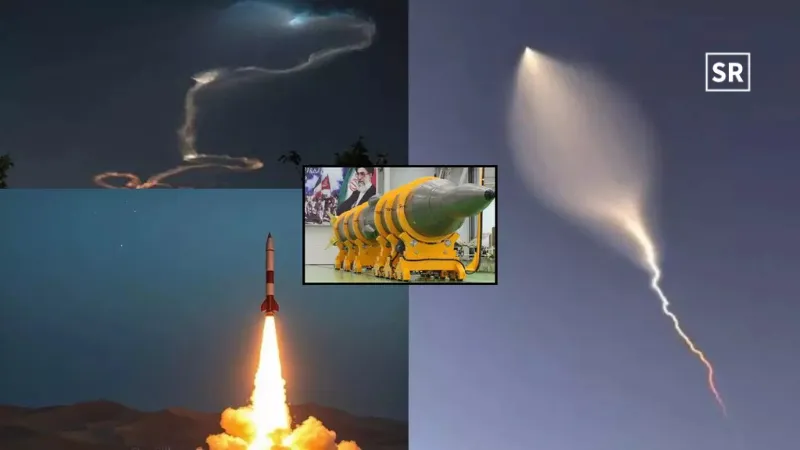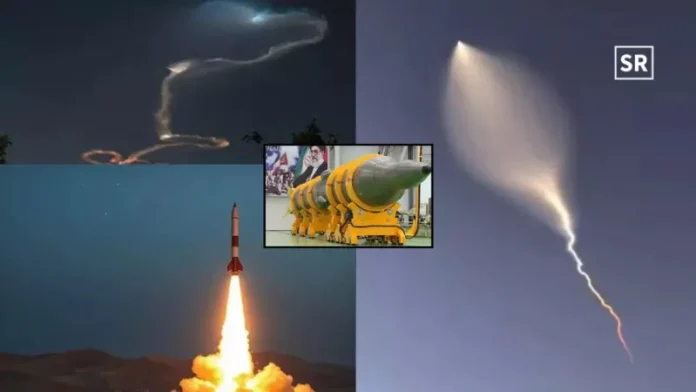
Table of Contents
Introduction
The Sejjil missile, also spelled Sajjil or Sejil, marks a significant milestone in Iran’s missile development program. As a two-stage, solid-fuel, medium-range ballistic missile (MRBM) it is a major departure from Iran’s older Shahab series which relied on liquid-fuel propulsion.
The introduction of Sejjil demonstrates Iran’s growing self-reliance in defense technology and its ambition to enhance its regional and long-range strike capabilities.
Its real-world application also reveals a shift in gears in Tehran’s deterrence calculations and response.
The Sejil, or “Brimstone”, is classified as a surface-to-surface ballistic missile and was developed entirely inside Iran by the Ministry of Defence-run Aerospace Industries Organisation.
Sejjil Background and Development
Iran began focusing on solid-fuel missile technology in the late 1990s, learning from its experience with short-range solid-fuel systems like the Zelzal and Fateh series. The Sejjil program likely drew from foreign assistance early on but is largely believed to have been developed domestically over the past two decades.
The first successful test flight of Sejjil-1 occurred in November 2008, with the Sejjil-2 being tested in May 2009. These tests showed that Iran could produce longer-range, solid-fuel missiles capable of being launched rapidly from mobile platforms—improving their survivability and reducing warning times for adversaries.
Sejjil Technical Specifications
Feature Details
Type Medium-Range Ballistic Missile (MRBM)
Stages Two
Propulsion Solid fuel
Range ~2,000 to 2,500 km
Payload 500–1,500 kg (conventional or nuclear-capable)
Launch Platform Road-mobile Transporter-Erector-Launcher (TEL)
Guidance Inertial + possible GPS + terminal guidance
Accuracy (CEP) ~50 meters (Sejjil-1); ~10 meters (Sejjil-2)
Length ~18 meters
Weight ~23,000 kg
Variants of the Sejjil Missile
- Sejjil-1: The original version was tested in 2008. Two-stage solid-fuel design with an estimated range of 2,000–2,200 km.
- Sejjil-2: First tested in 2009. It includes improved guidance, enhanced range, maneuverable reentry vehicles (MaRV), and radar-evading coatings.
- Sejjil-3 (unconfirmed): Rumored to be a three-stage missile with a range of up to 4,000 km, potentially placing parts of Western Europe within reach. No open-source evidence confirms its existence, but some Iranian officials have hinted at its development.
Combat Use and Recent Developments
Until recently, Sejjil had never been used in combat. That changed in June 2025, when Iran reportedly used Sejjil missiles during the escalating conflict with Israel. The Islamic Revolutionary Guard Corps (IRGC) claimed successful strikes on Israeli military intelligence centers and critical infrastructure.
While Israeli missile defense systems, including Iron Dome and David’s Sling, intercepted many of the missiles, at least one Sejjil reportedly landed near Be’er Sheva, damaging a civilian hospital and causing injuries.
This marked the missile’s first confirmed use in combat and underscored the seriousness of its strategic role.
Regional and Global Implications
The introduction of Sejjil has several geopolitical implications:
- Increased Iranian Deterrence: Iran can now retaliate quickly and accurately against regional threats.
- Destabilizing Effect: The missile adds to the arms race in the Middle East, prompting rivals like Israel and Saudi Arabia to enhance their missile defenses.
- Pressure on Diplomacy: Sejjil’s capabilities are a bargaining chip in negotiations around Iran’s nuclear and defense programs.
- Potential Nuclear Delivery System: While Iran denies pursuing nuclear weapons, Sejjil is considered capable of delivering a nuclear warhead, should Iran ever develop one.
Challenges and Limitations
Despite its strengths, the Sejjil missile program faces several challenges:
- International Sanctions: Restrict Iran’s ability to import advanced guidance components.
- Accuracy Claims: Independent verification of its stated accuracy (10-50 meters CEP) is difficult.
- Risk of Escalation: Its use in real combat could trigger large-scale retaliation or war.
Conclusion
The Sejjil missile represents a leap in Iran’s missile technology—offering mobility, speed and strategic reach that were previously beyond its grasp.
As a solid-fuel, road-mobile MRBM with a combat-tested track record it stands as a central component of Iran’s evolving military doctrine and deterrence strategy.
While its full potential remains untested, the Sejjil missile has already reshaped military calculations in the Middle East. Its development sends a clear signal: Iran is investing in fast, flexible and long-range systems to secure its interests and project power across the region—and possibly beyond.
1. What is the Sejjil missile?
The Sejjil is a medium-range ballistic missile (MRBM) developed by Iran. It uses solid fuel and has a range of approximately 2,000–2,500 kilometers.
2. Why is the Sejjil missile important?
It is Iran’s first successful solid-fuel, two-stage missile, giving it faster launch capability, greater mobility, and improved accuracy—making it much harder to detect or stop before launch.
3. What is the missile’s range?
The Sejjil can travel 2,000 to 2,500 km, making it capable of reaching:
Israel
Saudi Arabia
U.S.bases in the Gulf
parts of europe





